The low-mileage car gets a road trip
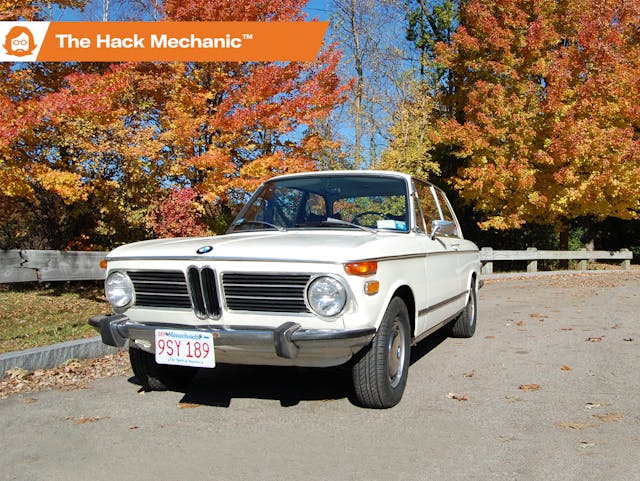
I’ve written repeatedly about “Hampton,” the remarkably original survivor 1973 BMW 2002 that I bought in Bridgehampton, Long Island, from its original owner 3 1/2 years ago. Part of the appeal of the car was that, when I bought it, it had 48,125 documented original miles that aligned with its intact survivor vibe.

Now, 48,000 miles is a funny number. It’s not remotely in the same league as the sub-thousand-mile cars that get bid up to crazy prices on Bring a Trailer. But a BMW 2002 with that mileage is a rare beast. When I bought my ’74 Lotus Europa Twin Cam Special nine years ago, it had 24,000 miles on it. That’s not why I bought it, but I did think that the mileage made it something special. I was completely wrong. There appear to be a fair number of Europas, particularly Twin Cam cars, with that kind of mileage on them, because a) They were generally bought as third, not first or even second cars, b) The water pump is integrated with the front timing cover, the seal leaks from sitting, and because of the mid-engine design, the engine has to be removed to rebuild the pump, which is part of the reason behind c) the widely-repeated saying that Lotus stands for “Lots Of Trouble Usually Serious.”

But a BMW 2002 isn’t like that. These cars were bought as primary transportation, owners drove the wheels off them, and they were and continue to be generally quite reliable, making sub-50,000-mile 2002s pretty uncommon. When I bought Hampton in the spring of 2019, it had been sitting in a barn for a decade due to a change in family fortunes. I don’t usually flip cars, but I saw dollar signs. I cleaned it up, sorted it out, put it on Bring a Trailer, and was surprised when it didn’t meet a reasonable reserve. I think the main reason why was that although folks say that they love original survivor cars (“It’s only original once,” and all that), BaT’s click-and-bid-bid-bid machinery is more hospitable to eye-candy cars with powder-coated subframes and dry-ice-blasted engine compartments, neither of which Hampton has. I wasn’t planning on keeping the car, but when it didn’t sell, that seemed to be my lot, at least for a while.
During this unexpected second act of the play of ownership, I’ve been very conscious not to rack up the mileage. Virtually all the 800-ish miles I put on the car was running it back and forth to the warehouse in central Massachusetts where I rent space. I never really “pleasure-drove” it anywhere. While some component of that was that the nearly-bone-stock Hampton doesn’t have the snap of my fuel-injected 2002tii or my other 2002, with its high-compression twin-Webered-and-cammed engine, the bigger reason was that I was adamant about not rolling it over to 49,000 miles (“le petit rollover”), much less 50,000 (“le grande rollover”).
However, over the past few months, there was a shift in my thinking. First, the idea of hoarding mileage—owning a car and not driving it because of worry that that will affect its value—is antithetical to everything that I do. The value of Hampton will be increased by a) detailing the engine compartment and undercarriage (the latter of which will likely never happen), b) wire-brushing, treating, and repainting the little bit of seam rust on the hood and the door bottoms, c) having paintless dent removal performed on the little dings, and d) the passage of time. I now realize that zeroing in myopically on the mileage and saying the car be worth $Y with 49,000 on it but only $X with 51,000 is just plain silly.
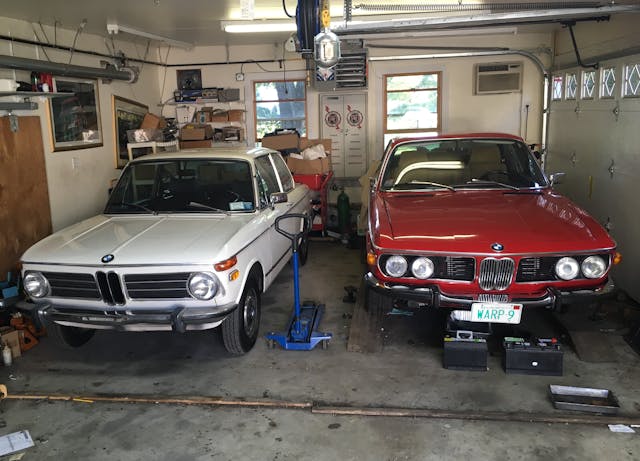
Second, even though the other 2002s, the Lotus, the BMW M Coupe, and other cars are well-ahead of it in the pleasure-driving queue, Hampton is the prettiest 2002 I own, and its survivor vibe gets under your skin. The original paint and bone-stock interior are often conversation pieces. I had a guy chat me up recently outside a liquor store and ask if he could smell the car’s interior. Rather than look at him askance, I understood the request completely. The horsehair padding (“Gummihair,” as the Germans called it) of the seats has a very characteristic smell. He opened the door, stuck his head in, inhaled deeply, and smiled. “That is exactly how a BMW 2002 is supposed to smell,” he said. He was right.
And so I began to use the car more. After identifying and fixing a long-standing hard-starting problem, I focused on another carburetor issue, that of lean-running. Using a portable exhaust gas analyzer I bought 40 years ago in a pawn shop in Austin, I verified my suspicion that the car’s hesitation at even throttle and numbness on modest acceleration was indeed accompanied by the meter on the gas analyzer swinging well into the lean zone. I ordered an assortment of idle and main jets, and with a little tweaking, was able to a) get the needle on the gas analyzer to sit much closer to the middle, b) the hesitation to go away, and c) the car to wake up when I squeezed the throttle.

But while iteratively doing that, I was running the car a few exits up and down I-95 and put another hundred or so miles on it. As I homed in on the final jetting, I didn’t cringe as the odometer did le petit rollover to 49,000 miles. Instead, I smiled at the fact that I’d largely let go of the “I shouldn’t be driving it” issue and was actually performing useful tuning that would increase my driving enjoyment.

Since my usage of the car was increasing, I installed a spare Recaro-like Konig driver’s seat I had in the basement. While I absolutely love the look of BMW’s 1970s seat pleating, the big wide, flat horsehair-padded seats are uncomfortable for anything other than short drives, and with my back injury in August, I need all the lumbar support I can get. Plus, for enthusiastic driving, the bolstered seat held me in place much better. Not that I was sliding the car around entrance ramps. That would be pleasure driving (haha).

I was so pleased with this shift in tone and purpose that I decided that Hampton deserved something of a coming-out party. After all, even close friends of mine in the vintage BMW world had never seen the car. One good friend joked that the car was an urban myth. So, I took it to “BMW Day” at the nearby Larz Anderson Auto Museum in Brookline, Massachusetts. There were any number of cool cars there, including a survivor 1935 315/1 roadster, so it’s not like Hampton was the belle of the ball. But enough of my local 2002 friends laid eyes on it to retire the “urban myth” joke.
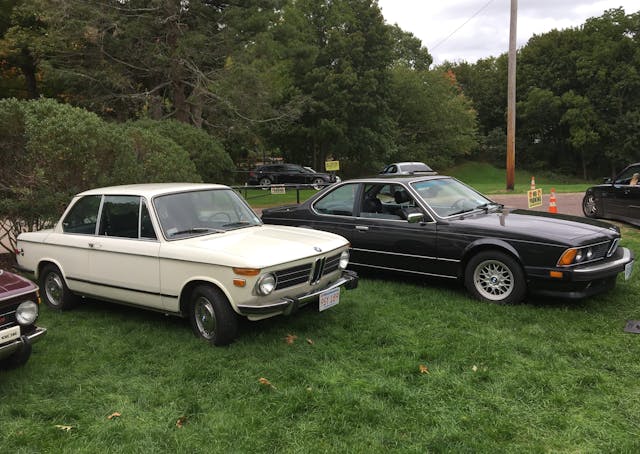

In fact, it got the gears turning in my brain to something bigger:
Road trip!
The following weekend, my wife, Maire Anne, and I were planning to drive up and see some close friends in Manchester, Vermont, one of whom is a former bandmate who had asked me to sit in with his band in a gig they had during Columbus Day / Indigenous People’s Weekend outside the Orvis building. Road trips in smelly, old, vintage cars aren’t really my wife’s thing, so I was planning on taking my smooth and quiet 2003 BMW 530i. Plus, rain was forecast, and as much as I love pounding out big miles in the vintage cars, driving them in drenching rain is stress-inducing to the driver and rust-inducing to the car.
However, the morning we were planning to leave, I looked at the weather radar, and it showed that the precipitation bands were predicted to head well north of our destination, so any rain was likely to be episodic rather than drenching. I ran the smelly-old-vintage-car question past my better half, and she signed off on it, so into the trunk went the Tech21 guitar amp, and onto the back seat went the Peavey T-60 and the Taylor GS guitars. The projected 150-ish-mile trip was a Goldilocks-just-right distance, as I felt comfortable bringing a toolbox and a few reasonable spares (fuel pump, distributor cap, plugs and points, fan belt) but eschewing the floor jack, two gallons of antifreeze, timing light, and more that I’d take on a real road trip.

We had a picture-perfect drive up through fabulous foliage. The windows were down and the sunroof open for most of it. As we approached Manchester, we could see the storm center hovering ominously off to the northeast, but although the temperature dropped about 15 degrees, there was absolutely zero rain.

The only problem we had on the trip was that my supposed hard-starting fix last month wasn’t the magic bullet I thought it was. With the colder overnight temperatures, the car had trouble starting in the morning. Adjusting the automatic choke so it rotated hard closed didn’t fix it. Then the problem started happening even when the engine was warm. Fortunately, I brought a battery jump pack just in case I ran the battery down and needed to self-jump, which I did. Curiously, starting with a fully open throttle turned out to be the magic trick. I’m still not sure what the cause of the problem is. But all in all, it was no more than a minor annoyance.
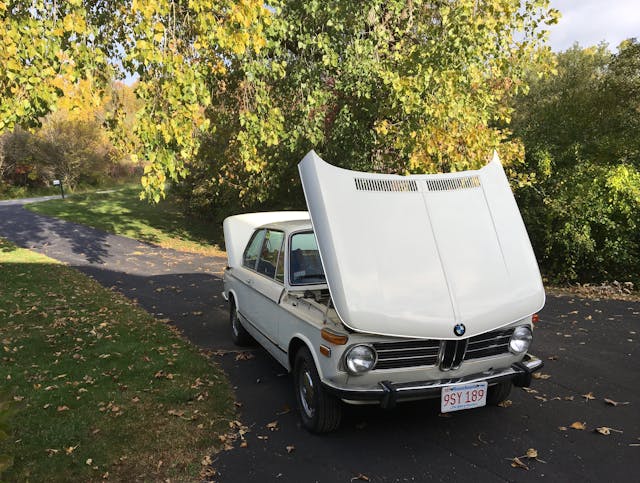
One of the reasons BMW 2002s had a cult following when they were new is that they were small sports sedans that did a lot of things well. They were stout, had an acceptable amount of power, could seat four, had a real trunk, and were almost criminally smile-inducing on a curvy road. All of that is still true. Further, while there’s no pretending that you’re not in a 50-year-old car in terms of wind noise, the car’s two-liter engine, snickety four-speed gearbox, front disc brakes, McPherson strut front suspension, and fully independent rear suspension still make the 2002 a joy to drive. That can’t be said of all vintage cars. I may have missed the extra power and the wonderful wind-up of the 2002tii when I wanted to squeeze the accelerator to keep pace with traffic up a hill, or the roar of the dual Webers and the hot cam when I wanted to mash and pass, but what Hampton lacked in snap, it more than made up for in panache.
In addition, not only were Maire Anne and I happy road-tripping the perky little 2002, Hampton seemed happy. Before the car was put in storage in 2009, it had been a summer car in the Hamptons, used only to tool around between a vacation home and the beach. This was probably its first road trip in over 20 years. Deciding to drive the car, to use it as intended instead of hoarding its mileage like virginity in a 19th century British novel or vintage scotch seemed to lift a pall that had descended upon it after it didn’t sell on BaT and I stuffed it away.
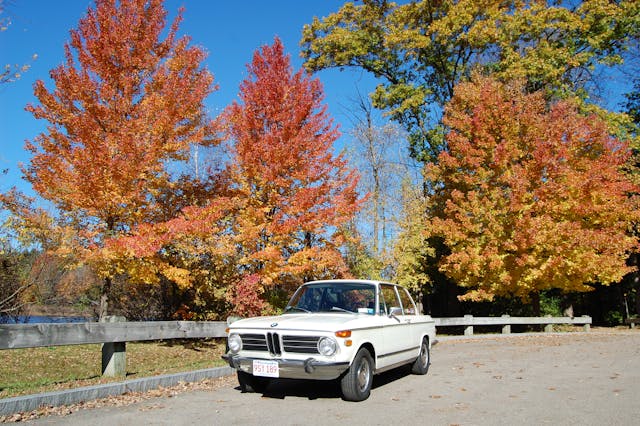
The roughly 310-mile round-trip ticked the mileage up to 49,365. I can’t say that I’m going to start planning road trips in the car to Nome or Seattle or even Asheville. It still is likely this car is sojourning with me rather than a long-term soulmate. And I have other cars, and they all get their turn. But that’s the point—Hampton is now getting its turn with the rest, and I will now use the car for what I want instead of feeling like keeping the mileage down is the single most important thing.
After all, when le grande rollover happens, the car and I should be livin’ the dream on some road trip, not running cardboard boxes down to the recycling depot. Or getting an inspection sticker. Or tweaking the jetting on I-95.
***
Rob Siegel’s latest book, The Best of the Hack MechanicTM: 35 years of hacks, kluges, and assorted automotive mayhem, is available on Amazon. His other seven books are available here, or you can order personally inscribed copies through his website, www.robsiegel.com.

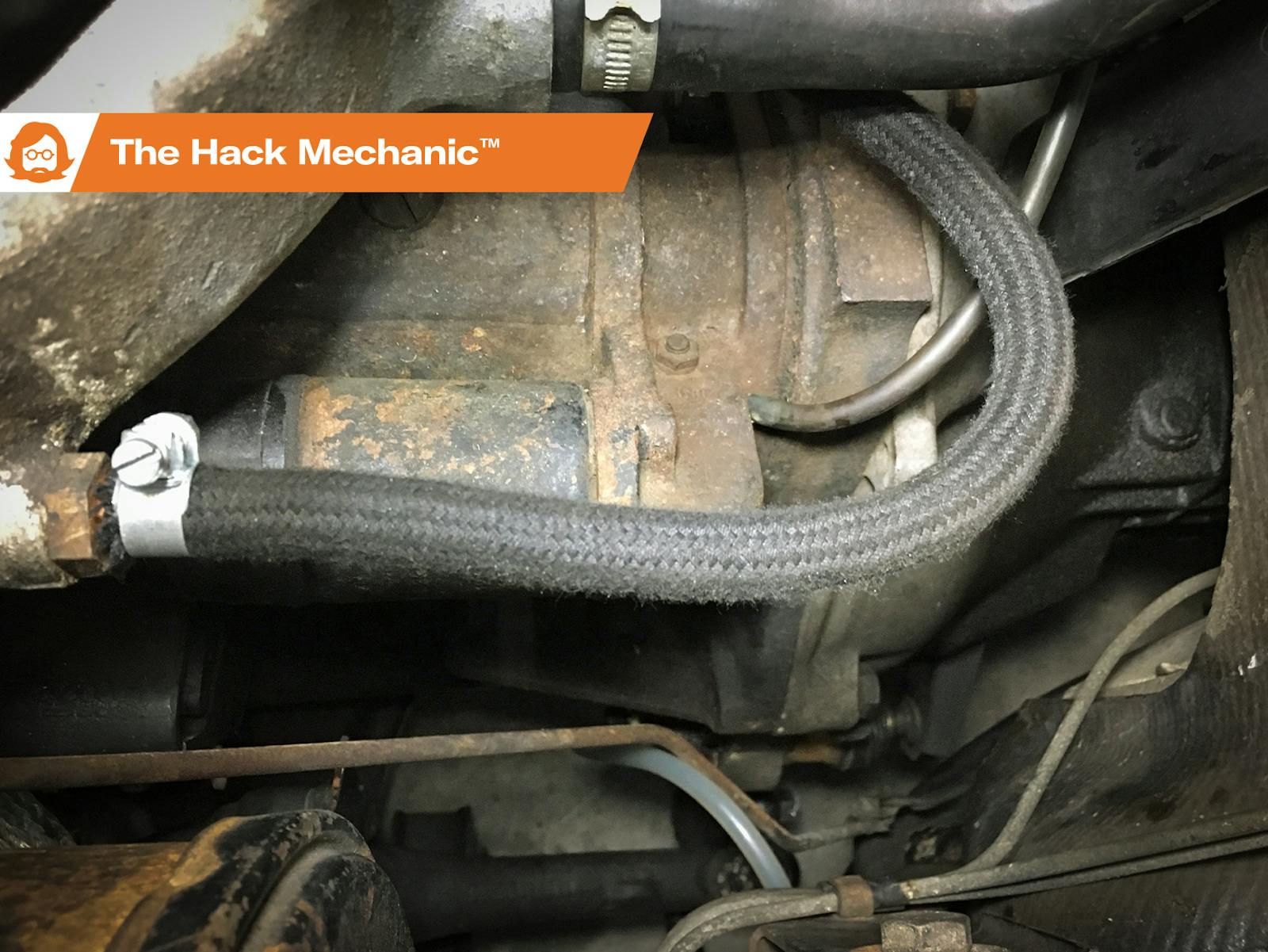
I know exactly how you feel – convinced my wife to let me buy a 2011 45th. anniversary Shelby 350GT, with ALL the bells and whistles (no kicker stereo though) – gonna keep it forever and sell it for a fortune!! -RIGHT – the damn thing sits in my garage and whispers to me every day (“drive me,drive me, I don’t mind the miles”). So the semi-garage queen now has 5,900 miles and counting – it’s just such a blast to drive on a 2 lane country road (or the 2-mile straight down the road between the cotton fields – 165+ comes up fast till you back off).
On the BAT discussion – my wife has now decided that she would really have more of the garage and I’m pushing 80 myself, so could I please sell the 100-year anniversary Harley and the car. The new car pricing ran into the mid-80K’s and I would like to try and at least recoup my initial cost – but BAT turned me down because I balked at going under 65K for the reserve – they thought more like 52K would be the right number because of the “high” miles – although they may be right on this, I just can’t stand the psychological defeat that comes with giving up something that has given me so much fun. (Dusted off a brand-new GT500 the other day – we started the run with me in 2nd. gear and about 40 mph, and I just walked away from him).
So the bike and car are “on sale” – sort off – not really pushing them but if somebody makes the offer…!
If you have them, drive them. What good is a car that just sits in a garage somewhere squirreled away where no one can see or enjoy them. Besides, what if some little kid riding around in a belly button mini van sees your ultra cool car and decides they want to get into the hobby? Wouldn’t that be cool?
I can relate to got to drive it comment.
Having owned a variety of early British, German and Italian cars. I always drove them sometimes more than my “regular” rides of the day. These days all that is left is a 2091 Vw Cabrio. A great little ride not likely to be discovered by collectors on this side of the pond. But unlike earlier BMWs and Brit cars. Parts are another issue. My latest issue an instrument cluster that dies regularly with no reliable used or existing new old stock part anywhere. Unless someone out there has one, lol. However the love of the drive has changed my mind about selling it at least a half dozen times. So I will soldier on until one of us passes or another survivor catches my eye.
As an ex owner of several Bay-emm-vey including a 1968 1800a and at least 5 “roundies” I loved the article. Most of mine succumbed to the dreaded tin worm and the fatal rear shock tower fail. I had a early smooth marker lamp/footed BMW Roundel 68 1600 that was relatively rust free but in a moment of weakness I literally gave it away . Dumb move ..along with my restored 67 GTV Alfa. My wife somewhat likes the horsehair seats of my old “ZOOS” . A note on that: when I worked at a dealer service in the 80’s an elderly lady asked me “How much are these Zoo’s cars and are they any good” She was asking about my 69 2002 in the lot !
Cars are meant to be driven.
Guitars are meant to be played.
Neither should be stuffed in a garage.
“That is exactly how a BMW 2002 is supposed to smell,” sealed it for me. The most evocative words in the article!
I will always drive my cars. I’ve often said if I wanted to just look at my cars, I can do that on the internet for free! The whole reason of owning a special car is to enjoy the journey with them. I love all my cars and even just a quick trip is special, compared to driving my truck that I use as a daily driver. I have never cared about adding miles, in fact all my cars seem to run more smoothly when they’re exercised regularly. The only thing that will keep me from driving any of my cars is inclement weather.
These pictures bring back fond memories of my second car – a BMW 1600 in the same white. I loved that car, but as a teenager pined for a convertible and so moved to an MG Midget. I certainly wish that I had kept the Bimmer!
There’s low mileage, and then there’s concours condition. The first does not imply the second. For the vast majority of low mileage survivor cars, the best choice is to drive them and enjoy them. I’m glad you got there with the 2002. Yours is a fun car and a great car. Drive it!!
What, no one mentioning a solution to the hard starting, how it somehow seems too rich when cooler? I vaguely remember this problem but what it is exactly is escaping me.
Great read. I’ve been driving my grandfather’s ’65 Galaxie more often this summer, and just turned 90,000 (s)miles on this “one-family Ford”.
I have a small engine car among other things with 306,000 miles and change. It is an inheritance from someone who drove carefully, used the thing to back and forth to Church, Town and so on. I drove it very
carefully for some time until I thought it’s a car; it’s built to be driven. So now it is a daily driver, I watch its
oil changes, fix what needs to be fixed (very little) so it’s the opposite of Rob’s BMW but it’s the same story
except with lots of miles.
Motion is Lotion, Rest is Rust. DRIVE what you Love, Love what you DRIVE. I watched my 560SL roll over 100,000 miles and frowned, but when my 84 20th Anniversary Mustang (first new car) rolled over 200,000 miles I smiled as now it looks like it only has 682 miles on it (5 digit odometer, whereas the MB has 6 digits). I have thoroughly enjoyed the over 200,000 miles I’ve put on the Mustang. Making memories isn’t that what it is all about. If they become beasts of burden and you are afraid to drive, sell it and move on.
I say drive it, 100ish miles is the just right amount of long drive but not so short that nothing gets some exercise.
As usual, great article! I would add that maybe next time you decide to dip your toe in the BaT pool make sure they know who is selling the thing! You are a published, well known, and possibly internet-famous car dude – also the band thing – and that provenance means $ signs.
I have a 1987 MC SS (for 35 years) with 105000 miles owned since new. Looking at it I only put 3000 miles a year (on average) or 250 miles per month with almost 99% being short or now show or local driving. My biggest concern taking her on a long haul that a break down will happen, even though I keep everything possible new or current, with little or no chance that anyone with know how to repair or have parts.